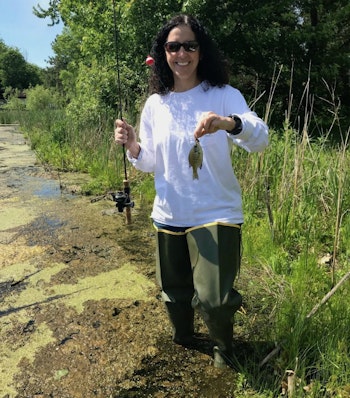Spring is a great time to be on the water, but when it comes to catching spawning sunfish, the shore-bound fisherman can often be just as successful as anglers in boats. The reason? Sunfish typically spawn along the shoreline in 1 to 5 feet of water, and they seek areas with a firm bottom, which makes wading an effective technique.
Through the years, I’ve introduced many beginners to fishing during the sunfish spawn. In my opinion, it’s the absolute best time to do so. At no other time of the year are sunfish as aggressive, so strikes come fast and often — provided you keep in mind these three tips.
1. Location, Location, Location
Throughout much of the year gamefish occupy a wide range of area throughout a lake, but this isn’t true during the spawn, especially for sunfish. To catch spawning sunfish, you must first find their beds. This is easiest if you choose a lake with water clarity of at least 3 feet, and 5 feet of visibility is even better.
While it’s true sunfish will move into dark-bottom bays as these waters quickly warm during early spring, sunfish need firm bottom to build nests and deposit eggs. If these bays have firm bottom areas available, then sunfish will stay, but most often the fish will leave these muddy/silty bays to find shorelines with sand or gravel.
Begin looking in the dark-bottom bays for light-colored areas indicating hard (sand) spots, and if you don’t find them, branch out along the shoreline. If you’re fishing from a boat, stand in it, use your outboard or trolling motor, and then look into the water with polarized glasses as you slowly cruise the shoreline. In clear-water lakes, the bedding areas might resemble massive honeycombs, which each sunfish bed adjacent to a few others. Individual beds could be as small as a dinner plate, or as large as a garbage can cover.
As water clarity is reduced, you might see only a hint of light brown among a dark backdrop. Motor past the light-colored sandy spot, marking it with a shoreline reference, then return later to fish it.
I can’t emphasize enough the need to find the spot-on-the-spot. Example: I recently took a beginner fishing from shore on a lake near her home, and the public dock was crowded with panfish anglers, young and old. Because I’d scouted the area previously, I knew the area within casting distance of the dock was all muddy/silty bottom, with a lot of weed growth (lily pads, etc.). However, I also noticed that 75 yards down the shoreline, the habitat changed. I could see some rocks and gravel on the water’s edge. This was in front of someone’s home, so fishing from shore wasn’t possible (I didn’t want to mess with asking for permission), so I packed a lightweight pair of waders and a pair of hip boots for our adventure. Specifically, I wore breathable LaCrosse Alpha Swampfox waders, and my fishing partner wore uninsulated LaCrosse Big Chief hip boots (photos below).

We walked in the water along the shoreline, never getting any deeper than 18 inches. Initially the wading was difficult due to the mud and silt in the dark-bottomed bay (near the dock), but soon I could feel the bottom composition change under my boots. I stopped sneaking along the bank when I spotted light-colored areas the size of a pickup, and when the sun peeked through the clouds, I could see sunfish guarding individual beds. I knew we’d hit the jackpot. (Spoiler: In a period of 90 minutes, my fishing partner caught at least 50 sunfish, including some big ones! I observed the dozen anglers on the dock catch only three tiny sunfish during the same period. Location is critical.)
2. Tackle — Keep It Simple
After you find spawning sunfish, there’s no need to go crazy with your presentation. In the scenario I described above, my fishing partner used a 5-foot ultralight spinning rod matched with a tiny spinning reel spooled with 4-pound-test mono. Lure choice was a 1/32-ounce leadhead jig (plain, no plastic or hair). I attached a small bobber (the size of a quarter) 18 inches above the jig. For this simple presentation, there’s no need to mess with a slip-bobber or split shot.

While sunfish might attack soft plastics rigged on a micro jig, you’ll have much faster action and catch many more fish if you use live bait. I prefer nightcrawlers. I pinch off a 3/4-inch piece of ‘crawler and thread it on the hook. Ideally, the crawler will touch the leadhead and cover the straight shank of the hook. Don’t worry about trying to cover the hook point because it doesn’t matter.
3. Be Ready for Quick Hits
The key to enticing strikes from spawning sunfish is putting your lure in front of them. Honestly, it’s that easy 99 percent of the time.
Assuming you have a pickup-sized zone of spawning beds surrounded by submergent vegetation (the light-colored area surrounded by dark), the only mistake you can make is casting too far, or too far left or right, and landing your jig in the weeds (the dark area). Even aggressive spawning sunfish won’t attack a hook caked with weeds.
When your jig-and-bobber combo lands over the light-colored area (spawning beds), be ready for an immediate strike. Bedded sunfish aren’t hungry necessarily, but they are in “protect mode.” As soon as they see your jig sinking toward their bed, they will hammer it. A novice might not be ready for such an immediate strike, so talk them through it. Often, the small bobber will plunge under the surface a split-second after it touches down. Be ready! (Note: Most panfish anglers use bobbers and jigs/hooks that are way too big.)
There’s no reason for a cross-their-eyes hookset on sunfish. In fact, doing so will only cause your nightcrawler to tear off the jig if a fish drops your lure as you’re setting the hook. Instead, point your rod tip at the bobber as it lands, then begin reeling while raising your rod tip after your bobber signals a strike.
If you miss the sunfish, stop reeling, and wait; another strike is likely to happen within seconds. Give your bobber and the jig a little twitch to entice another strike. If your bobber sits motionless for 10 to 15 seconds without a strike, then you probably lost your chunk of crawler. Reel in and rebait.

Final Thoughts
Perhaps you're asking: Why use a leadhead jig instead of a plain hook? Through experience I’ve learned that sunfish can easily swallow a plain hook, while that almost never happens with a jig. Also, if you use a plain hook, you have to mess with adding split-shot to the line.
Carry a small pliers or forceps with you to help remove hooks quickly, and be sure to wet your hands before touching fish to avoid removing their protective slime layer.
I also recommend carrying a small towel to keep your hands clean after repeatedly pinching off nightcrawler chunks.
Finally, remember to practice selective harvest when keeping fish for the table. Click here to read a recent article of mine on the topic. Keep enough for a meal, but there’s no reason to stock your freezer.









